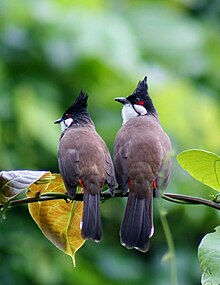Rotohrbülbül
| Rotohrbülbül | ||||||||||||
|---|---|---|---|---|---|---|---|---|---|---|---|---|

Rotohrbülbül ( Pycnonotus jocosus ) |
||||||||||||
| Systematics | ||||||||||||
|
||||||||||||
| Scientific name | ||||||||||||
| Pycnonotus jocosus | ||||||||||||
| ( Linnaeus , 1758) | ||||||||||||
| Subspecies | ||||||||||||
|
The Rotohrbülbül ( Pycnonotus jocosus ) is a Real Bulbul from the family of the bulbul . It is common in tropical Asia from India to Southeast Asia and China . It was introduced by humans to New South Wales ( Australia ), Mauritius , Spain and Florida .
The population situation of the Rotohrbülbül was classified in the IUCN Red List of Threatened Species in 2016 as “ Least Concern (LC) ” = “not endangered”.
features
The Rotohrbülbül reaches a body length between 18 and 20.5 centimeters. They weigh between 25 and 31 grams. There is no noticeable gender dimorphism .
The red-eared bulb has a brown top and a whitish bottom, a dark ring, open at the front, ends on the chest at shoulder height. It has a black hood that is pointed and narrow. There is a red spot behind each eye. The cheek, throat, chest, and stomach are white. The tail is long and brown with white feather tips, the rump itself is orange.
There is no sexual dimorphism . The males and females are colored the same, only the young birds are more dull.
Its flight is similar to that of the woodpecker .
Subspecies and their range
In the large distribution area a number of subspecies are distinguished.
- Pycnonotus jocosus abuensis : Northwest India. The white spots on the underside of the tail are missing, the chest band is not closed.
- Pycnonotus jocosus emeria : East India, Bangladesh, is only missing in Myanmar in the east, south-west Thailand , the feather bonnet, the forehead, the neck and the indicated collar are jet black.
- Pycnonotus jocosus fuscicaudatus : West and Central India. The black collar is closed on the chest.
- Pycnonotus jocosus hainanensis : North Vietnam and South China.
- Pycnonotus jocosus jocosus : Southeast China - the red ear mark is bordered by a black feather border at the bottom.
- Pycnonotus jocosus monticola : East of the Himalayas to northeast India. From the south of Tibet to the north of Myanmar and the south of China. The body plumage of this subspecies is overall very dark.
- Pycnonotus jocosus pattani : The south of Myanmar, Thailand and the north of Malaysia as well as Laos and south-east Indochina
- Pycnonotus jocosus pyrrhotis : Northern India and Nepal The chest ligament is not closed. The tail feathers are white.
- Pycnonotus jocosus whistleri : Andaman, smaller than the nominate form and has shorter hood feathers.
habitat
The Rotohrbülbül lives in sparsely forested regions with bushes and shrubs and also in agricultural areas. It also opens up urban space and occurs in parks and gardens. You hear him more often than you see him, occasionally he drops conspicuously on the floor. He builds his nests in bushes.
Its more frequently perceived relative, the Russbülbül , is seen more often in human settlements. As is often the case with sparrow-sized birds, its threats in human proximity are more like cats and electrical cables on poles.
Way of life
Rotohrbülbüls feed on fruits, nectar and insects. The loud and memorable call is a sharp kink-aa-ju , the singing is an insulting chatter. His voice resembles a happy human whistle. When there are young birds in the nest, a human whistle triggers the youngsters' reaction.
Reproduction
The breeding season varies with the area of distribution. The nest is a deep bowl nest that they build from grass, leaves and plant fibers. The clutch usually consists of two to three eggs. The nestlings hatch after a breeding period of 12 to 14 days. Since the brood is picked up when the first egg is deposited, the nestlings hatch asynchronously. At the beginning they are mainly fed animal food by the parent birds. They fledge after about two weeks.
attitude
Rotohrbülbüls have been kept for a long time. In zoological gardens they are often shown in large aviaries and tropical houses.
literature
- W. Grummt , H. Strehlow (Ed.): Zoo animal keeping birds. Verlag Harri Deutsch, Frankfurt am Main 2009, ISBN 978-3-8171-1636-2 .
- Theo Pagel , Bernd Marcordes: Exotic soft-eaters . Eugen Ulmer Verlag, Stuttgart 2011, ISBN 978-3-8001-5192-9 .
Web links
- Pycnonotus jocosus inthe IUCN Red List of Threatened Species 2015.4. Posted by: BirdLife International, 2012. Retrieved February 3, 2016.
- Rotohrbülbül pictures
- Videos, photos and sound recordings of Pycnonotus jocosus in the Internet Bird Collection
- Voice of the red-eared bulb on Xeno-Canto
Single receipts
- ↑ Pycnonotus jocosus in the endangered Red List species the IUCN 2017. Posted by: BirdLife International, 2016. Accessed December 16, 2017th
- ↑ Pagel, Marcordes: Exotic soft-eaters . P. 100.


